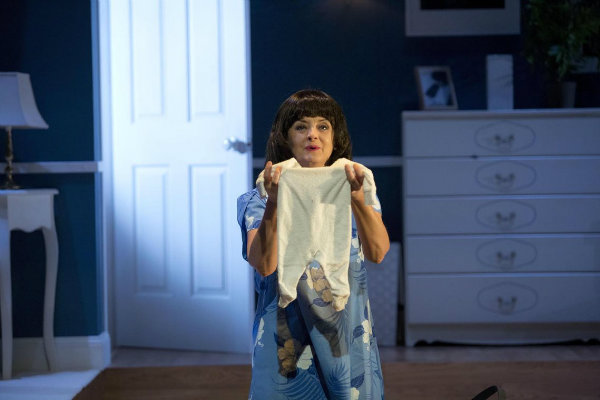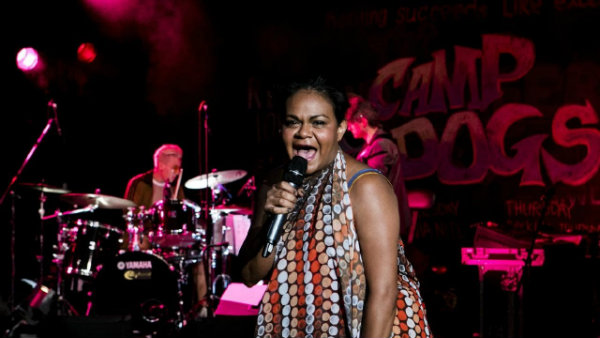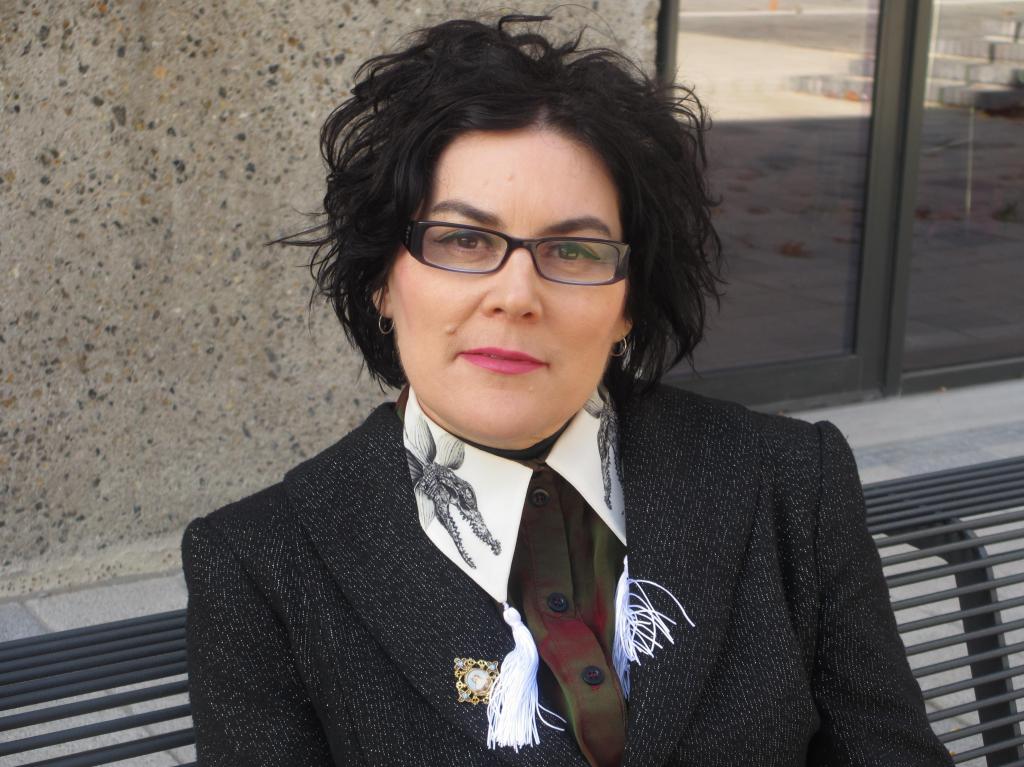Playwright Alana Valentine. Photo credit: Vicki Gordon.
This is an edited version of a speech given by Alana Valentine at Belvoir, Surry Hills, on Monday 3 December.
Theatre-makers. We are the ones who put on a show. We are the ones who want others to see what we have made. If an actor falls on a stage and no-one is there to see them, we are the tribe who can all agree that that is a crying shame.
The priority of my work as a playwright has been, and continues to be, the deep engagement of local audiences with Australian drama, a recognition that goes beyond a sentimental familiarity with place names and nostalgia. It is a complex contract that what is being seen on stage is going to be about a life and world the audience might know, or if not, might delight in knowing. And there is, in that perception, something far beyond a cosy familiarity. In fact, it can be quite the opposite because in it can be a shock of immediacy, a reality from which you cannot distance yourself, where the sometimes ugly truth is not shielded from being directly about you. But there is also, in it, a profound certainty that because the lives of the people on stage matter for the next two hours then so does your own. It is both a confrontation and affirmation precisely because the people on the stage are in some way like you.
What I do as a playwright is get people into the theatre who will extend the story that the actors are telling on the stage out into the house, beyond the fourth wall and into an elusive, never entirely cohesive, but a connected, collective audience response. What I always aim to do is gift to the audience an experience where they move beyond the isolation of being an individual and seem, even momentarily, to think and feel and perceive as a community.
It’s intricate what I’m trying to name because I’m not suggesting that we abandon either our individual intelligence or identity in that moment. I’m not talking about being subsumed into the mob, but I am talking about creating the conditions where an audience can experience the simultaneous nature of both the self and the group. That for me is great live theatre.
‘I am talking about creating the conditions where an audience can experience the simultaneous nature of both the self and the group. That for me is great live theatre.’
Earlier this year I was on tour with actors in the Northern Territory of Australia.
They did a show, the production manager and stage manager packed up the van for Colin, our roadie to drive away through the night before us, we slept and the next morning we followed Colin’s path to the next venue for the stage manager and production manager to unpack and rig the set before the next show. And then we did it again. And again. And again. Twenty-one venues over three months. Three states, and the Northern Territory.
They’ve brought the writer along because I am conducting writing workshops on the day before the play. This offers us connection with the local writing community in each of the towns we visit, and I offer them my experience and engagement with their own artistic ambitions.
The play was Letters to Lindy, a two act drama about the 20,000 or more letters that the public wrote to Lindy Chamberlain-Creighton which she has carefully archived and which I have spent about five years reading, transcribing, finding the copyright owners for and compiling into a play. The dramatic spine of the work is a verbatim monologue in Mrs Chamberlain-Crieghton’s own words.
Letters to Lindy premiered for Merrigong Theatre Company in July 2016, with Lindy, her husband Rick Creighton and son Reagan Chamberlain in attendance. At the end of the play, Lindy accompanied me to the stage to face a heart-felt standing ovation. Later on, in the foyer, Lindy went to the microphone and said, ‘This is the most powerful thing that has been done on my story, and the most true to what I lived through.’
Lindy was at the show in Darwin when we played to nearly 1000 people in the Darwin Entertainment Centre. They told us that they had never had to open the dress circle for a play before. ‘You mean an Australian play,’ I said. ‘Any play,’ they told me.
At the end of that incredible show, in the city that had incarcerated this innocent woman, this grieving mother for more than three years, those 1000 people stood up as Lindy Chamberlain-Creighton took the stage. They responded to this theatrical opportunity to collectively give back, to collectively face what was done, to absolve the past in some small but important way.
It is one thing to learn that a thousand people every year care enough to still write to Lindy 38 years later. It’s quite another to be in a room full of a thousand people letting go of their shame.

Jeanette Cronin in Letters to Lindy. Photo credit: Lisa Tomasetti.
We have an identity that is beyond our individuality. We have an identity which we hold in concert with our knowledge of our specific, isolated selves and sometimes, if the play is good, we may be able to enter into that identity in a collective sense. Unfortunately, sometimes, if the media and the mood and the collective mentality is bad and seeks to whip us up into a herd, we enter into a group sensibility that is destructive and irrational and sometimes even murderous.
What was it that happened in early 1980’s Australia that saw a woman sent to jail for life for supposedly murdering a baby that was unquestionably taken by a dingo? We acted as a jury and a legal system and a culture to do that.
I was asked in the Territory, by someone working in the arts, why did I feel the need to bring this shameful chapter up again? Why did I need to remind people of what was done to her? What good can come of that, they said to me? When I replied that she might like to think of the show as an opportunity to give something back, there was a confused shake of the head. ‘You are here to sell us tickets and for that you promise to entertain us,’ she said. ‘No,’ I replied, ‘we are here to witness ourselves and other people changing their minds; to transform not only what was done by us but to us, to be carried back to forgiveness and release or any other response we might individually make of it.’
In 2018, nearly 2019, I would like to take an idea out for a walk, the idea that there no longer is, if there ever was, such a thing as a general audience. I think it’s a myth that can only exist alongside the myth of a monoculture. I suggest that the myth of the general audience must go the way of the myth of the normal person, the myth of the average Australian. You wouldn’t walk into a café and order a standard coffee, you’re unlikely to talk about a traditional voter. Are we not part of a generation whose success has been to interrogate all forms of generalisation? So why do we continue to refer to a general audience? And please, I’m not taking issue with the nature of the adjective as a collective descriptor, I’m actually leaning into the definition of general as imprecise, inexact, sweeping, and vague. I’m questioning what it is that we’re referring to as general.
‘I suggest that the myth of the general audience must go the way of the myth of the normal person, the myth of the average Australian.
I’m also not being pejorative or seeking to denigrate the audience that we already have in our theatres by refusing to call them general. I am not saying, as I sometimes hear non-theatre goers say, ‘Oh, but the audience for theatre is very samey.’ And I say, ‘No it’s not, you never go to theatre or you wouldn’t say that.’ Sometimes if I’m feeling really combative, I’ll say, ‘Not at my plays, Nelly,’ or if I’ve been home alone too long I will ask in a small voice, ‘how can you know a person’s age, class or cultural heritage just by looking at them? You would need to look at the Australia Council’s last National Arts Participation Survey, published in June 2017.’
And then you’d really be able to argue with me. Because although the overview records brightly that 98% of Australians engage with the arts and more people recognise the positive impacts of the arts, there are some sobering findings as well. Yes, there have been general increases in all the markers of people’s attitude to the impact of the arts – an increase in the sense that the arts add to our wellbeing and happiness; an increase in the sense that the arts shape Australian identity; an increase in the sense that the arts enhance our ability to think creatively, develop new ideas and express ourselves. But scroll down and engage with a tricky little date bar on the figures and you can find an alarming statistic that has been declining in leaps and bounds.
In 2009, 85% of people believed the arts should receive public funding; in 2013 it was 79%; in 2016, it is at 66%. Not good. And then there is a curious, quite offensive statistical line: ‘The arts tend to attract people who are somewhat elitist or pretentious.’ I thought, hah, that’s going to have gone down, the cultural cringe is a thing of the past. Hold your breath. In 2009 it was 33%, about a third of people; 2013, 30%, less than a third; 2016, it was up to 43%, almost half. What’s going on?
Maybe this is a perfect example of something called confirmation bias that I have been learning about in data analysis; that is, people might just agree because the fact that a question about elitism and pretention is even there in the survey affirms such an attitude. For the last year I’ve had a Fellowship at the Charles Perkins Centre, a world class science facility at the University of Sydney, so I know that you can misinterpret data, in that case, scientific findings and in this case audience participation statistics. I know that it is dangerous for a lay person such as myself to be let loose on such data, unsupervised.
But let’s stop making or allowing others to make derogatory or negative remarks about the age, culture or gender of our current theatre goers. These are our loyal audience, the people whom I know as intelligent, nuanced in their understanding of the world, attracted to ideas and interested in people and things other than themselves. And yes many of them are opsimaths, and so as to prevent you reaching for your smart phone that means, ‘One who learns late in life.’ But they are also many other things that you can’t tell from statistics. I suppose what I am trying to posit, in interrogating the general audience as a myth, is to ask: what are the specific qualities of theatre goers that make them anything but general and how might we attract more community members with those qualities to our theatre spaces? Not just along age, culture or gender lines but along ‘content of their character’ lines, along ‘boldness of their vision’ and ‘depth of their community spirit’ lines?
Orhan Pamuk, the great Turkish novelist, writes that ‘Novels are unique structures that allow us to keep contradictory thoughts in our minds without uneasiness, and to understand differing points of view simultaneously.’ It’s a great of description of drama and I think of our ideal audience – those who can keep contradictory thoughts in their minds without uneasiness, and understand differing points of view simultaneously.
I was not the child who dragooned their relatives into sitting on the couch, turning off the TV and watching their children put on a play. That is not my story. But it is a memory I have heard told so many times by so many people in the theatre that I sort of long to make it my own. To be one of that imaginary group of children playing dress up, leaping out of wardrobes and from behind sofas, to be clapped indulgently by attentive parents. I still want that. For the quietly listening audience to psychically cross that liminal space between the stage and the house. To explore work that continues my process of delighting with meaning the established theatre audience, and has them muck in with the wildcard of an engaged, sometimes vocal, often new to theatre crowd.
The relationship between the audience and the stage can be savagely intimate, it can be coldly distant, it can be more fragile than faith, it can be as strong as love. It is alive with all the mystery and tedium and horror and incandescent joy of breathing in and out right now, breathing deeply and regularly, daring to be extreme and uncompromising, choking sometimes on our own hyperbole or slayed with despair when our endeavours, our artistry is not understood. Crippled with regret when we have been blunted or stale. When we have preferred delusional hope to discipline. When we have believed our own publicity and skated along an intellectual surface, surprised that the cracks have sent our audience falling through into the ice cold water of banality.
‘The relationship between the audience and the stage can be savagely intimate, it can be coldly distant, it can be more fragile than faith, it can be as strong as love.
People often ask artists if they think about the audience and they mostly reply, ‘No, not really, I do what I want and then let the audience make what they want of it.’ But that is very different to a kind of snobbish indifference to the audience. A kind of hierarchy of artistic taste that infers that the audience should simply be grateful for the superior aesthetic sensibilities of the artists. Yes, we have an obligation to be innovative and daring and disruptive and invite audiences to follow us in that. But in 2018 anywhere in the world, arguing that audiences should simply attend because of some notion of culture as educative and refining for a particularly exclusive, mono-cultural class is no longer sustainable. As artists we take into our bodies and minds and spirits the collective concerns of our communities alive today.
I have spent a lot of time in the Northern Territory of Australia. I love the spirit of country that comes up out of the earth through the soles of your feet when you are standing on that sovereign Aboriginal land. In January 2008 I directed a public reading of my play Watermark in the Katherine cinema, as a commemoration for the tenth anniversary of the 18 metre flood that had literally wiped the town off the face of the earth. There were 18 community performers and we decorated the stage with a line of blue silk cloths, to represent the flooding waters.
I will never forget the moment, almost towards the end of the play, remembering the people who had died as a result of the flood waters. Using the transcript from the Territory Parliament, it named the people and detailed the circumstances of their death. At the time, the parliamentarian reading this had asked his fellow politicians to stand for a minute’s silence. I included this as an authentic part of the record. We had asked a few people associated with the cast to stand at this moment in the reading, to see if it might encourage others in the audience to do the same. Almost before the invitation to stand was issued, the entire house got to its feet and stood, silent, respectful, grateful to be able to respond to the pain and heartbreak outlined. It was a precious moment that anyone who works in theatre will know well – that moment when the work of art becomes a conduit for spontaneous community expression. It’s not a moment you can plan or control, but you can set up the conditions for it before you surrender to a phenomenon much bigger than yourself.
I have had the privilege of witnessing that moment many times in my career. The closing night of Run Rabbit Run on this stage, when, at the very end of the work, a riot happened only streets away in Redfern, unknown to the cast and the assembled house. But those who were there that night and learnt later of what had happened would swear that some gremlin of the madness and delirium from that event crept down the road and into the audience at Belvoir who went absolutely nuts that night as if Souths had actually won the grand final (as they were to do years later).
It was there during the whole run of Ladies Day, at Griffin Theatre. On the opening night I stood arm in arm with gay men still living out and proud in Broome. It was a play that acknowledged domestic violence and rape within gay relationships, so it gained the supportive response of some in the gay community, but also an incredibly vocal young audience. Young woman especially wrote to me about the pain of demeaning their own abuse for fear it was comparatively inconsequential. The determination of these young adults to call out abuse of any kind is utterly inspiring.
When my play Head Full of Love, set at the Alice Springs Beanie Festival and about kidney disease was produced in Darwin, the after show audience gave generously to a fund we raised for the Purple House, the Western Desert Nganampa Walytja Palyantjaku Tjutaku Aboriginal Corporation where I had done my research. The actors Colette Mann and Roxanne McDonald collected $60,000 dollars and gave it back to Central Desert mob to fund a mobile kidney dialysis machine called the purple truck that drove out to country.
In 2011 I worked with a Redfern community organisation and the Blue Knot Foundation, then known as Adults Surviving Child Abuse (ASCA). I conceived a public performance where the reader would be unknown and I could not control who would perform. As audience members took their seats it was explained that they would be asked to participate in the performance by electing to step up and read testimonial transcripts of abuse. This created an astonishing tension and unity in the house. We watched people come up from the audience to read the stories of survivors – sometimes they’d cry and struggle find the courage to go on, but then they would create self-esteem by being active in their own healing. Not knowing whether the readers were abuse survivors, or family or friends was a metaphor for the way in which child abuse lives all around us, unseen and unacknowledged in the lives of adults, while having its destructive, debilitating effect.
It is the rare, unifying, utterly intangible response of the audience during or after the performance that makes me want to keep writing for theatre. It still has to work with metaphor and suspense and humour and the kinds of contradictions that come from lived experience, not ideological dogma. I am sometimes confused by people who dismiss audience-focussed or community-engaged art as worthy, and not one hundred times as artistically disciplined as any other form of theatre. I suppose what confuses me is the kind of argument that goes something like, ‘Yes but all the things you’re talking about Alana, all the audience members who are part of the community of interest, or people in the show, or have some engagement with the theme of the show or behave in a rowdy or differently engaged way, that’s all just ephemeral. You’re not doing that. You don’t control who comes to the show and gives the audience that specific experience.’
But I do strategise for a very specific audience cocktail when I am thinking about writing a show, I do think about the people it will attract and how they might affect the character of the audience. To say that I’m not mixing my palette with the audience as one of the ingredients is incorrect. Just as a visual artist who anticipates that their work is going to factor in people touching it or sitting on it or dressing in it thinks about the interaction factor, all I’m saying is, so do I. And then when the play delivers that warmth and that playfulness and heart and bounty of engagement and cultural diversity, that is what myself and my theatre collaborators have been aiming for.
I hope that community-engaged theatre professionals will continue to be recognised as artistically innovative, with the courage to elicit change in the character and content of the audience lauded as serious a form of artistic rebellion as changes to the theatrical elements and performance style. I hope that arts criticism and journalism might also investigate responses from the community of interest about the ideas being interrogated and elucidate how particular subcultures and informed audiences might understand the work differently.

Ursula Yovich in Barbara and the Camp Dogs. Photo credit: Brett Boardman.
At the end of the first preview of Barbara and the Camp Dogs here at Belvoir the audience stood. And we all went home home, and I and Ursula Yovich, who co-wrote and performed the play were so relieved and delighted down to our bones but we thought, ‘Ah, maybe it was a particularly nice house.’ And then at the second preview, in the audience was Ripple Effect, an all-girl band from Maningrida, many of whom were Ursula’s cousins and countrymen, and all through the show they were calling out encouragement and clapping. Toward the end they came down onto the stage and danced all through the encore, as if they were in a pub. And the energy leaked into the audience from the show and by the end everyone was on their feet dancing. And we thought, ‘Oh yes but that may have been because of the Arnhem Land mob.’
And then it happened again on the third preview because there were more countrymen in and the energy of the early previews was flowing back from the band and the performers to the audience. And then again they stood on the opening because it was just so joyful. And then on every single sold out show for three weeks full of old rockers and young funksters and people who love live music, and music people who don’t usually rate songs in plays and so, so many others new to this theatre, and loyal to this theatre. If you want to see illustrated what I am talking about when I say, to feel like you are part of something bigger than yourself, it is most surely there in Leticia Cacéres’ production of Barbara and the Camp Dogs.
When no-one would give me access to their audiences in Sydney, when the ratio of male to female playwrights on stage was abominable back in the bad old days, oh, about four years ago, during all those years I was lucky enough to be employed by regional companies, in the Northern Territory by Jo Duffy and the Darwin Festival, in Canberra by Caroline Stacey at the Street Theatre and by Simon Hinton at Merrigong Theatre Company in Wollongong.
Those regional companies and many others all over Australia are, doubtless, doing some of the most innovative work for their audiences in the Australian theatre landscape. And by working with them I have developed a keen eye for how to ready regional audiences to attend plays that they might, initially, think are not for them; how to tempt those audiences into paying for seats on shows that are enthusiastically embraced by radical regional taste-makers and go on to tour Australia. The Australia Council for the Arts’ November 2017 research summary, The Arts In Regional Australia, concluded that the vast majority of people living in regional Australia recognise positive impacts of the arts in their lives and are only a very little less inclined to acknowledge the positive impacts of the arts (84%) than those in metropolitan areas (86%).
‘Those regional companies and many others all over Australia are, doubtless, doing some of the most innovative work for their audiences in the Australian theatre landscape.’
Seven in 10 people in regional Australia believe the arts have a ‘big’ or ‘very big’ impact on stimulating their minds (68%); almost seven in 10 believe the arts impact their ability to express themselves (67%, up from 60% in 2013); 65% believe the arts impact their ability to think creatively and develop new ideas, up from 57% in 2013; 57% believed the arts impact our sense of wellbeing and happiness, up from 52% in 2013; and 57% believed the arts shape and express Australian identity, up from 44% in 2013. The regions are so punching above their weight when it comes to audience development it’s positively electrifying.
I have had so many intellectually vivid discussions with regional Artistic Directors and venue managers about how they are continuing to engage their audiences with art. One of the most revealing was about not just the myth of the general audience – one AD described every regional show as a completely bespoke audience. But another talked in revelatory terms about the dangers of burdening the young audience with the responsibility of being a kind of saviour of the theatre, of how young theatre goers are, of course, vitally important but it is utterly lazy thinking to assume that all audience members of a particular age are the same or will want the same sort of show.
In regional companies they talk about a sophisticated notion that audiences can be divided not along age lines but along psychometric lines, perhaps using the five big psychological traits that are now routinely used for election campaigns. Apparently they are openness, contentiousness, extraversion, agreeableness and neuroticism. I think it is interesting, even for a playwright, to understand that your work may be aimed at the adventurous in life, of any age; might be aimed at the worriers and prophets of life, of any sexual preference; might be enjoyed by the peacemakers, of a diversity of cultural backgrounds; might appeal to the fun-time lovers, beyond gender or geographical postcode.
There are still too many people who are simply too intimidated to enter a theatre. I would love it if ‘general audience’ really meant a collective of infinitely different Australians and others from all corners and walks and aspects of contemporary Australian society. I’m calling it because I think vaguely referring to the general audience can become an excuse for not thinking about who the audience is, for not working to augment freedom of speech and freedom of association, which we still so preciously have in this country, with the human right of a genuine range of people to see themselves on a public stage.
I want to finish with a provocation to my fellow artists about audience. Whose engagement are you really interested in? Who do really work for?
Me? I wouldn’t have spent this much time and done this much work if I was just trying to realise my personal creativity or liberate my individual vision. If you’re one of us, one of the tribe who want to go to the theatre, or want make theatre it’s because you can’t understand what it is to be in the world without feeding it through the body and mind and spirit and longing of a theatre artist, you just can’t get your bearings unless you see aspects of your life played out on a public stage so that you can get that chance to really open your eyes.
Our job is to bring the utterly overwhelming beauty of the world, the frightening fragility with which we maintain our freedoms in this country, onto the public stage for examination in a sufficiently entertaining and rousing way that it can endow the future with the legacy of us. And my argument is that if you keep calling it a general audience, perversely, that leads to a pool that is too narrow, too limited, too habituated to be as effective as we need it to be to go forward.
I’m not saying that you have to take responsibility for getting the entire audience in. Every writer of colour and every writer of difference knows what it is like to suddenly be expected to get in an audience from their cultural group.
Because I’m a lesbian I do happen to know a lot of homosexuals, and parents of homosexuals, and sons and daughters and sisters and brothers and non-binary siblings of homosexuals, and neighbours and god-children and nieces and nephews and cousins and work colleagues of homosexuals, and differently- abled homosexuals and their friends, and so many First Nations tiddas, and religious people who support homosexuals. I also know a lot of Rugby league fans and incarcerated women and men, and marine pilots and beanie makers and sex workers and international students and Jewish Australian entrepreneurs and Afghan Australian female engineers and Maori, Papua New Guinean and First Nations singers, and men and women living in big bodies, and chocolate, wine and tea connoisseurs and pro and anti-nuclear activists. And so to finish I give a shout out to all of you people, all of you who have come to see my shows over the years. Thank you, darlings, and of course I want to add that if you don’t come to the next one you are dead to me.
I’m not saying that writers need to become sole pied-pipers, wrangling in all the rainbow tribes of our wonderfully complex contemporary culture. But as these stories are told more and more by writers and actors and directors from a range of perspectives and identities, using other languages and theatrical traditions, I trust that they too will bring in new audiences as I have done.
‘The World will follow Joy,’ the poet Alice Walker tells us. If you love strange and fresh and pluralistic audiences as I do, and if you work to get into our theatres people who have never been part of an audience ever before, I promise you it will be one of the most beautiful gifts you can give to another human being – to take them with you to a live event and experience it, together.





